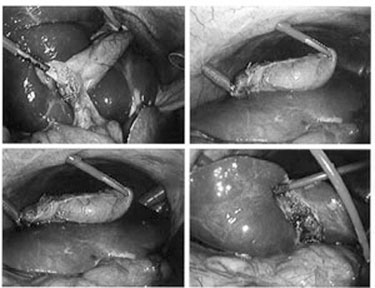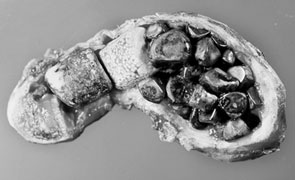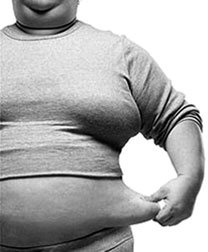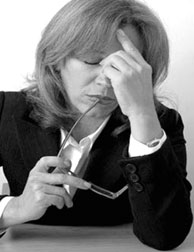|

Bladder stones -a galling experience
by Nilma DOLE
 |
|
An operation in progress to
remove stones in the gall bladder |
If you're forty, flabby, female and fertile, then you might be at a
risk of having gall bladder stones.
"One of the most common ailments in Sri Lanka is stones in the gall
bladder," said Dr. Karunasena Nanayakkara of the Kalubowila Teaching
Hospital.
Apparently, 10 percent of the population has gall bladder stones and
it is increasingly common in Sri Lanka with many surgeries being done
nearly every day. "Since many people have medical check-ups now, it is
possible to identify if you have gall bladder stones as opposed to
before when people didn't know they had it," said Dr. Rohana Siriwardena
who also works at the Kalubowila Hospital. He commented, "Nowadays,
people can check for gall bladder stones with an X-ray or an ultra-sound
scan.
However, in an X-ray, it isn't easy to detect how many stones a
patient has but an ultra sound is better". According to the doctor, a
patient can be referred to have an MRI (magnetic resonance imaging) or a
CT (computed axial tomography) scan to determine the extent of gall
bladder stones.
There is no scientific evidence to prove how gallstones occur but it
could be a multitude of factors like weight, gallbladder motility
(movement), and possibly diet. Certain factors like cholesterol and
diabetes could accompany gallstones but it varies between individuals.
 "Some patients might not have symptoms at the beginning but if they
don't check it, there can be deadly consequences" said Dr. Nanayakkara. "Some patients might not have symptoms at the beginning but if they
don't check it, there can be deadly consequences" said Dr. Nanayakkara.
About 90 percent of gallstones cause no symptoms. There is a minor
chance of developing pain during the first 10 years after gallstones
form. After 10 years, the chance for developing symptoms declines.
On average, symptoms take about eight years to develop. The reason
for the decline in symptoms after 10 years is not known, although some
doctors suggest that smaller stones may be more likely to cause symptoms
than larger, older ones. Acalculous gallbladder disease will often cause
symptoms similar to those of gallbladder stones.
The gallbladder is a small sac-like organ in the upper right part of
the abdomen. It is located under the liver, just below the front rib
cage on the right side. Gallstones (choleliths) are formed when
crystalline bodies made of calcium, cholesterol or pigmentation stones
arise in the gall bladder. The formation of gallstones can block the
bile duct which is instrumental in taking bile (that breaks down fatty
food) to the small intestine. "The gall bladder is a sac that stores
bile temporarily but it is not a vital element in the digestive system.
Those who have removed the gall bladder can live a normal life but their
bile duct is bigger", said Dr. Nanayakkara.
Dr. Siriwardena said, "If gallstones are not removed or treated, if
the stones obstruct the pancreas, then it would have a serious impact."
Obstruction of the common bile duct is choledocholithiasis and the
obstruction of the pancreatic exocrine system can cause pancreatitis. "Cholelithiasis
is the presence of stones in the gallbladder or bile ducts" said
Dr.Nanayakkara.
Speaking about the symptoms of the condition, Dr. Siriwardena said,
"Initially, a patient experiences extreme pain in the abdomen which is
called biliary colic. This pain can also spread to the back or a patient
may complain of a pain under their shoulder blades." Such symptoms may
happen after a fatty meal and can continue if the patient doesn't check
it.
"Other symptoms include vomiting, abdominal puffiness or bloating,
inability to digest fatty foods, belching and indigestion" he said.
Further he commented, "If there is a yellowing of the skin or eyes,
then the patient has jaundice and he should consult a doctor
immediately".
Dramatic symptoms also include dark urine, lighter stools, rapid
heartbeat and abrupt blood pressure drop.
With regard to treatment, Dr. Nanayakkara said that there have been
many magical cures offered by Ayurvedha experts for jaundice because
they think it is gastritis.
"This isn't true because gall bladder stones can cause jaundice. The
best thing would be to do an ultra-sound scan to see what the exact
problem is because if you don't diagnose the illness properly, the
patient can die" said Dr. Nanayakkara.
|

Stones in the gall bladder |
The Consultant Gastrointestinal Surgeon said, "In large operations if
we firmly believe that a patient has the risk of developing gallstones,
then we remove it surgically because it can grow over time. For example,
a patient having a single large stone can grow bigger or a patient
having multiple stones can cause problems." However, the doctors will
not do surgery if they don't deem the patient fit for it.
Dr. Rohana Siriwardena said, "There is oral ursodeoxycholic acid
treatment to dissolve cholesterol stones but the medication is costly
and the patient can develop gallstones if they don't take treatment
regularly." There is scientific research done on lithotripsy
(Extracorporeal Shock Wave Lithotripsy) which is a method of
concentrating ultrasonic shock waves onto the stones to break them into
tiny pieces which are passed out of the body but this will take time to
be adopted.
Dr. Karunasena Nanayakkara said, "Since we aren't sure how people can
get gallstones, it is always advisable to have a balanced diet, avoiding
fatty food and regular exercise to maintain a good BMI."
In making sure your gall bladder is safe, go for regular checkups and
do an ultra sound scan in addition to an X-ray. If you have cholesterol
or diabetes, make sure you keep it under control and also make sure you
don't eat much fatty foods because it can lead to gallstones.
It is difficult to determine if the gall bladder has to be removed
just to be on the safe side since some patients ask for appendix
removals when doing large surgeries. However, Dr. Nanayakkara said,
"Whether we like it or not, we are born with vital parts that make us
human. Science and nature have showed that even though we might have
ducts or sacs which serve no purpose maybe for bypass surgeries or major
necessities, we will need them one day." So make sure you have your
whole body intact because you never know when you will need your
unimportant parts one day!
Some facts about Gallstones
1. Gallstones occur when bile forms solid
particles (stones) in the gallbladder.
2. The stones form when the amount of
cholesterol or bilirubin in the bile is high.
3. Other substances in the bile may promote
the formation of stones.
4. Pigment stones form most often in people
with liver disease or blood disease, who have high levels of bilirubin.
5. Poor muscle tone may keep the gallbladder
from emptying completely.
The presence of residual bile may promote
the formation of gallstones.
6. Risk factors for the formation of
cholesterol gallstones include female gender, being overweight, losing a
lot of weight quickly on a "crash" or starvation diet, or taking certain
medications such as birth control pills or cholesterol-lowering drugs.
7. Gallstones are the most common cause of
gallbladder disease.
8. As the stones mix with liquid bile, they
can block the outflow of bile from the gallbladder. They can also block
the outflow of digestive enzymes from the pancreas.
9. If the blockage persists, these organs
can become inflamed.
Inflammation of the gallbladder is called
cholecystitis. Inflammation of the pancreas is called pancreatitis.
10. Contraction of the blocked gallbladder
causes increased pressure, swelling, and, at times, infection of the
gallbladder.
-Courtesy www.emedicinehealth.com
The evil of childhood obesity
by Dr. W.W.S.W.C. Fernando,
 The child's rapid growth takes place in three stages, the first two
years, adolescence and puberty. Obesity starts from the foetal growth
where you get larger babies than average >3kg. From six months onwards
we are giving supplementary and complementary feeding. The child's rapid growth takes place in three stages, the first two
years, adolescence and puberty. Obesity starts from the foetal growth
where you get larger babies than average >3kg. From six months onwards
we are giving supplementary and complementary feeding.
If we adhere to wrong feeding habits there will be excess calories in
the body resulting in obesity. If the child inherits familial obesity
you should be more conscious about his food habits. It is always better
to consult a doctor and nutritionist or dietician.
Working women leave the feeding to a second person which may perhaps
deny the opportunity for the child to get a balanced diet. So the child
will end up in obesity. When measuring the child's obesity, we take the
body weight and height, the body markers and indices according to the
child's growth of height and weight. WHO has formulated growth standards
by taking standard samples from all five continents including India and
Sri Lanka. According to those standards we measure the Sri Lankan
children sometimes ranking them overweight or obese. Many studies have
been done on childhood obesity.
A national level survey has revealed that childhood obesity is more
prevalent in the Western Province than other districts in Sri Lanka. The
obesity is found to be associated with childhood diabetes,
hypercholesterolemia etc., the survey pointed out.
Change of child food pattern to keep pace with the changing life
style and the increasing physical activity are the major targets of the
Management.
Industrialisation, working mother, increased family income, fast
foods are the main causes of childhood obesity.
The findings of the Anemia Survey-Sri Lanka by MRI revealed an
overweight and obesity percentage of five in Sri Lanka.
There is no other data on childhood obesity in Sri Lanka. A study
done by Prof. Wickramanayake observed that childhood obesity is about
10% in western province (Colombo schools).
Also there are lots of commercial preparations which result in
harmful effects. ex. Fat fast which contains herbal preparations reduces
water component of the body at the risk of death. When treating
childhood obesity it is always advisable to contact a nutrition
specialist or a physician.
The writer is a Medical Food and Nutrition Scientist and Specialist.
Cholesterol jumps with menopause, study shows
by Anne HARDING
 (Health.com) - Doctors have known for years that a woman's risk of
developing heart disease rises after menopause, but they weren't exactly
sure why. It wasn't clear whether the increased risk is due to the
hormonal changes associated with menopause, to aging itself, or to some
combination of the two. (Health.com) - Doctors have known for years that a woman's risk of
developing heart disease rises after menopause, but they weren't exactly
sure why. It wasn't clear whether the increased risk is due to the
hormonal changes associated with menopause, to aging itself, or to some
combination of the two.
Now, we have at least part of the answer: A new study shows beyond a
doubt that menopause, not the natural aging process, is responsible for
a sharp increase in cholesterol levels.
This seems to be true of all women, regardless of ethnicity,
according to the study, which will be published in next week's Journal
of the American College of Cardiology.
"As they approach menopause, many, many women show a very striking
increase in cholesterol levels, which in turn increases risk for later
heart disease," says the lead author of the study, Karen A. Matthews,
Ph.D., a professor of psychiatry and epidemiology at the University of
Pittsburgh.
Over a 10-year period, Matthews and her colleagues followed 1,054
U.S.women as they went through menopause. Each year the researchers
tested study participants for cholesterol, blood pressure, and other
heart disease risk factors such as blood glucose and insulin.
As they approach menopause, many, many women show a very striking
increase in cholesterol levels, which in turn increases risk for later
heart disease.
In nearly every woman, the study found, cholesterol levels jumped
around the time of menopause. (Menopause usually occurs around age 50
but can happen naturally as early as 40 and as late as 60.)
In the two-year window surrounding their final menstrual period, the
women's average LDL, or bad cholesterol, rose by about 10.5 points, or
about 9 percent. The average total cholesterol level also increased
substantially, by about 6.5 percent.
Health.com: The causes of high cholesterol
Other risk factors, such as insulin and systolic blood pressure (the
top number in a blood pressure reading), also rose during the study, but
they did so at a steady rate, suggesting that the increases- unlike
those for cholesterol- were related to aging, not menopause.
Of all the risk factors measured in the study, the changes in
cholesterol were the most dramatic.
The jumps in cholesterol reported in the study could definitely have
an impact on a woman's health, says Dr. Vera Bittner, a professor of
medicine at the University of Alabama at Birmingham, who wrote an
editorial accompanying Matthews's study.
"The changes don't look large, but given that the typical woman lives
several decades after menopause, any adverse change becomes cumulative
over time," says Bittner. "If somebody had cholesterol levels at the
lower ranges of normal, the small change may not make a difference.
But if somebody's risk factors were already borderline in several
categories, this increase may tip them over the edge and put them in a
risk category where treatment may be beneficial."
In a first, the study did not find any measurable differences in the
impact of menopause on cholesterol across ethnic groups.
Experts have been unsure how ethnicity may affect the link between
menopause and cardiovascular risk, because most research to date has
been conducted in Caucasian women. Matthews and her colleagues were able
to explore the role of ethnicity because their research is part of the
larger Study of Women's Health Across the Nation (SWAN), which includes
substantial numbers of African-American, Hispanic, and Asian-American
women. More research on the connection between menopause and heart
disease risk is needed, according to Matthews. The current study doesn't
explain how the increases in cholesterol will affect the rate of heart
attacks and mortality down the road, for instance.
As the SWAN study continues, Matthews says, she and her colleagues
hope to identify warning signs that will show which women are most at
risk for heart disease.
"The important thing is, ultimately, when we can figure out the
characteristics of women who have early signs of cardiovascular risk
that, if we don't do anything about them, could later result in a heart
attack." Women should be aware of the changes in risk factors that occur
around menopause, says Bittner, and they should talk to their doctors
about whether they need to have their cholesterol checked more often or
whether they should begin a cholesterol-lowering treatment, such as a
statin.
Maintaining a healthy weight, not smoking, and getting plenty of
exercise are essential to help keep cholesterol levels in check, Bittner
adds, and she points out that menopause can be an especially difficult
time for women to get enough physical activity.
"It often falls by the wayside because women in this age range take
care of kids, spouse, aging parents, and often work in addition," she
says.
"Midlife is a great time to make these changes," Matthews says. "If
we can essentially reset the course to a more health-promoting direction
in midlife, then that will have benefits for many years to come."
Wolf Ulian, Ph.D., the founder and executive director of the North
American Menopause Society, a nonprofit organization that provides
information on menopause to consumers and health-care professionals,
says the findings underscore that menopause is a good time for women to
adopt healthier lifestyles.
"Menopause is a milestone," he says. "It's a time to take stock and
take control and try to enhance the quality of your second half of
life." - CNN |

